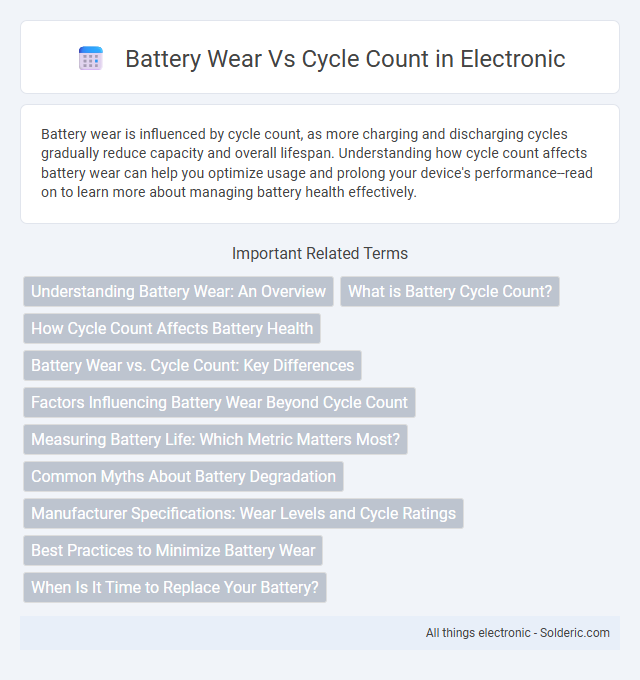Battery wear is influenced by cycle count, as more charging and discharging cycles gradually reduce capacity and overall lifespan. Understanding how cycle count affects battery wear can help you optimize usage and prolong your device's performance--read on to learn more about managing battery health effectively.
Comparison Table
| Aspect | Battery Wear | Cycle Count |
|---|---|---|
| Definition | Degradation of battery capacity over time. | Number of complete charge-discharge cycles. |
| Measurement | Percentage of original capacity lost (e.g., 20% wear). | Integer count of full cycles (e.g., 500 cycles). |
| Impact | Reduced battery runtime and efficiency. | Indicator of battery usage and aging. |
| Relation | Increases with higher cycle counts and usage. | Higher counts typically mean more wear. |
| Monitoring Tools | Battery health apps, system diagnostics. | Battery report tools, device settings. |
| Optimization | Avoid deep discharges and high temperatures. | Limit charge cycles to extend battery life. |
Understanding Battery Wear: An Overview
Battery wear directly correlates with cycle count, where each charge-discharge cycle gradually reduces overall capacity and performance. You can expect lithium-ion batteries to retain about 80% of their original capacity after approximately 300 to 500 full cycles, though factors like temperature and charging habits also influence wear. Monitoring cycle count helps predict battery lifespan and optimize device usage for maximum durability.
What is Battery Cycle Count?
Battery cycle count represents the total number of complete charge and discharge cycles a battery undergoes before its capacity significantly diminishes. Each cycle involves using 100% of the battery's charge, whether all at once or spread over several partial uses. Understanding your device's battery cycle count helps predict when battery wear might reduce performance or require replacement.
How Cycle Count Affects Battery Health
Cycle count directly impacts battery health by measuring how many complete charge and discharge cycles a battery undergoes, with higher counts indicating more wear and reduced capacity. As cycle count increases, the battery's ability to hold a charge diminishes due to chemical degradation, leading to shorter device usage times and potential performance issues. Monitoring your battery's cycle count helps anticipate when a replacement may be necessary to maintain optimal device functionality.
Battery Wear vs. Cycle Count: Key Differences
Battery wear refers to the gradual reduction in a battery's capacity and performance over time, while cycle count measures the number of complete charge and discharge cycles a battery undergoes. Cycle count directly impacts battery wear, as higher cycles typically correlate with increased wear and diminished capacity. Key differences highlight that cycle count is a quantifiable metric, whereas battery wear encompasses overall degradation influenced by usage patterns, temperature, and charging habits.
Factors Influencing Battery Wear Beyond Cycle Count
Battery wear is influenced by factors beyond cycle count, including temperature extremes, charge and discharge rates, and depth of discharge. High temperatures accelerate chemical degradation inside the battery, while fast charging generates heat, increasing wear. Your battery lifespan improves by avoiding excessive heat, using moderate charging speeds, and maintaining partial rather than full discharge cycles.
Measuring Battery Life: Which Metric Matters Most?
Battery wear is best assessed by cycle count, which tracks the number of complete charge and discharge cycles a battery has undergone, directly impacting its capacity degradation. While cycle count provides a quantifiable measure of battery aging, real-world factors like temperature, charge rate, and depth of discharge also influence overall battery life. Accurate measurement of battery health combines cycle count data with state of health (SoH) metrics for a comprehensive evaluation of performance over time.
Common Myths About Battery Degradation
Battery wear is often misunderstood, with many believing cycle count alone dictates battery lifespan, while factors like charge depth, temperature, and usage patterns have significant impacts. Contrary to popular myths, frequent partial charges cause less degradation than infrequent full discharges, and high temperatures accelerate chemical wear more than cycle count. Understanding these nuances helps optimize battery performance and longevity beyond simply tracking cycle counts.
Manufacturer Specifications: Wear Levels and Cycle Ratings
Battery wear is closely tied to cycle count, as manufacturers specify wear levels based on the number of charge-discharge cycles a battery can endure before capacity significantly diminishes. These cycle ratings vary by manufacturer and battery type, with lithium-ion batteries typically rated between 300 to 500 full cycles before reaching 80% of their original capacity. Understanding your battery's manufacturer specifications helps optimize usage and predict when battery replacement or maintenance may be needed.
Best Practices to Minimize Battery Wear
To minimize battery wear and extend cycle count, maintain lithium-ion batteries between 20% and 80% charge, avoiding full discharges or constant 100% charges. Utilize slow charging methods and keep devices in cool environments to reduce heat-induced degradation. Regular calibration through occasional full discharge and recharge cycles helps maintain accurate battery health readings.
When Is It Time to Replace Your Battery?
Battery wear directly correlates with cycle count, as each full charge and discharge cycle reduces the battery's capacity and overall lifespan. You should consider replacing your battery when its maximum cycle count, typically between 300 and 500 cycles for most lithium-ion batteries, is reached and you notice significantly diminished performance or shorter device usage times. Monitoring battery health indicators on your device helps determine the optimal time to replace your battery before it impacts your daily use.
Battery wear vs cycle count Infographic

 solderic.com
solderic.com